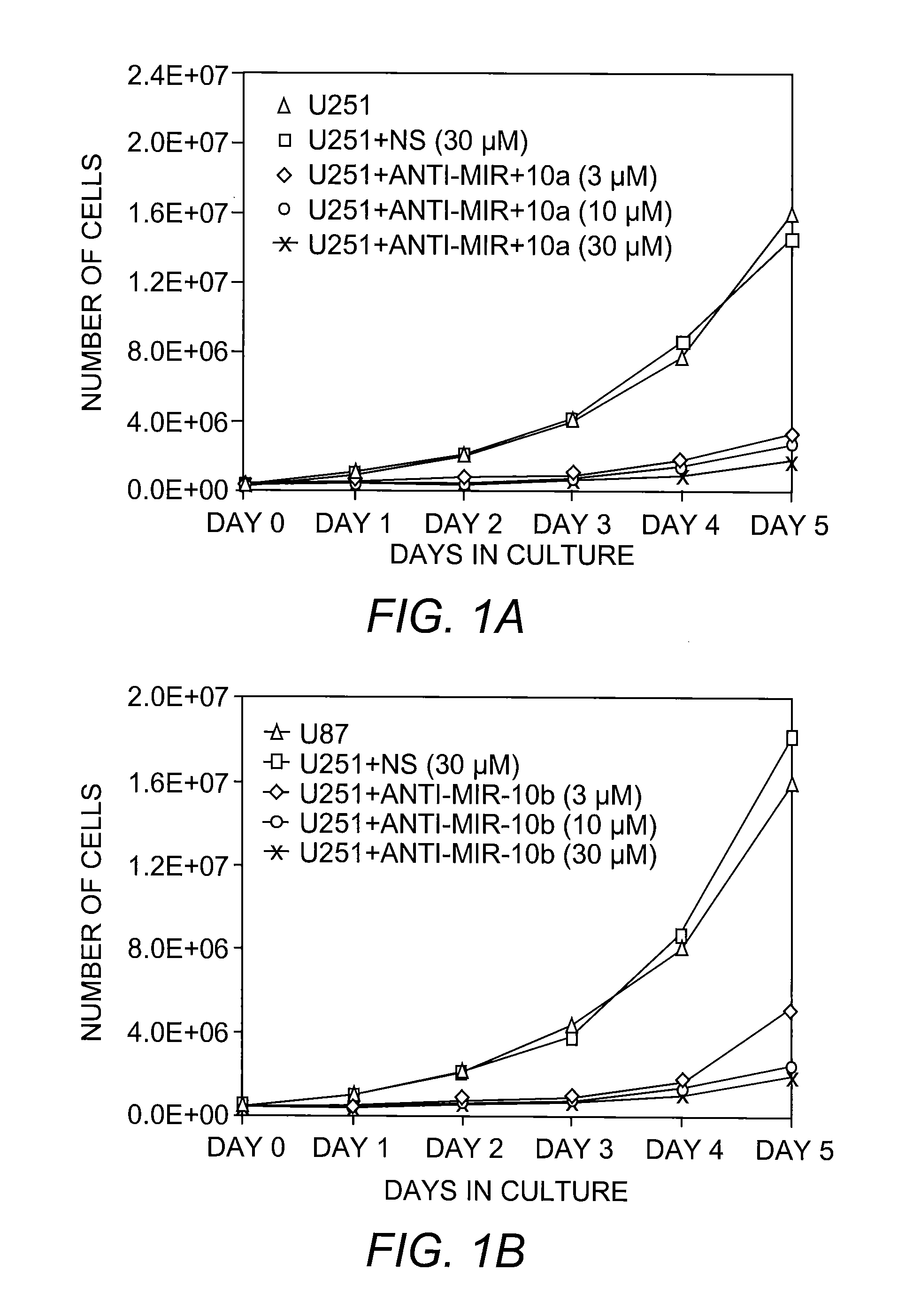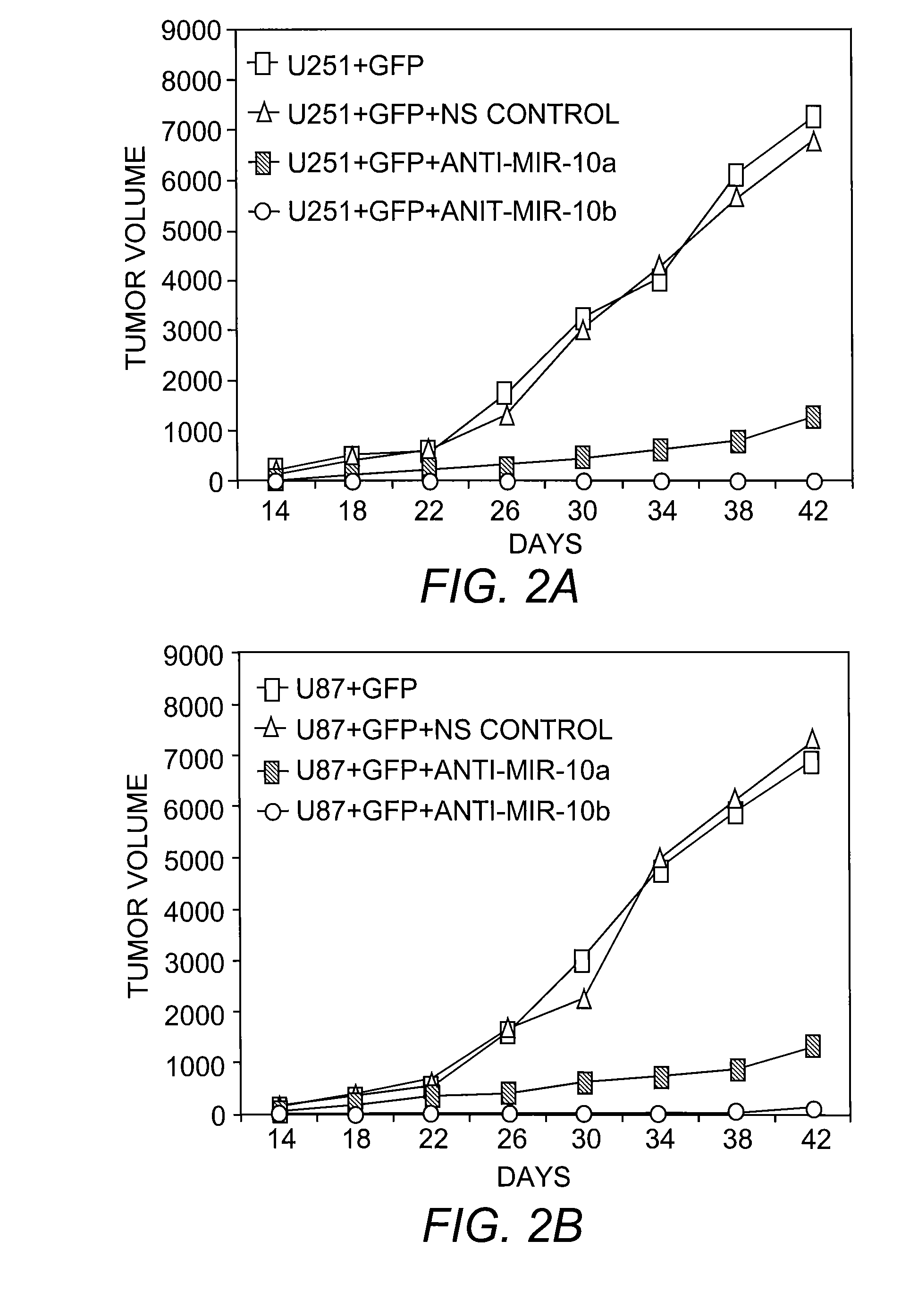MicroRNA-10 Antagonists and MicroRNA-10 Targets for Use in the Treatment of a Glioma
a technology of microrna-10 and glioma, which is applied in the direction of tumor/cancer cells, drug compositions, peptides/protein ingredients, etc., can solve the problems of limited efficacy and poor five-year survival rate of about 8%, and achieve the effect of decreasing the proliferation of glial tumor cells
- Summary
- Abstract
- Description
- Claims
- Application Information
AI Technical Summary
Benefits of technology
Problems solved by technology
Method used
Image
Examples
example 1
Role of miR-10a And miR-10b In GBM Oncogenesis
[0025]MiR-10a and miR-10b are candidate oncogenic microRNAs in GBM that are highly up regulated. To demonstrate that these microRNAs are involved in the initiation and / or progression of GBM, miR-10a and miR-10b expression in human GBM cells was analyzed. Based upon northern blot analysis, miR-10a and miR-10b were shown to be expressed in primary human GBM samples (2H, 4A10 and 64A44) when compared to normal brain tissue (NB1 and NB2). For this analysis, total RNA was isolated from the above-referenced samples by conventional methods and 20 μg of total RNA was loaded in each well. U6 loading controls were included for each blot.
[0026]Toward demonstrating the use of anti-mir10a and anti-mir10b in targeting glioma tumor cells, miR-10a or miR-10b expression was knocked down using 2′-O-methyl-modified oligonucleotides complementary to miR-10a or miR-10b in human GBM-derived cell line U87. Specifically, U87 cells were transiently transfected w...
example 2
Identification of Specific Targets of miR-10a And miR-10b And the Role of the Same In Regulating Oncogenic Processes
[0029]By comparing gene expression data from primary GBM and normal brain tissue with miR-10a and miR-10b levels, as well as using MiRanda target prediction algorithm associated with the Sanger MIRBASE, ZMYND11 (Zinc finger, MYND domain containing 11), RB1CC1 (RB1-inducible coiled-coil 1) and HOXD10 were identified as potential targets of mirs-10a and miR-10b. In this respect, down-regulation of miR-10b in GBM cell lines was shown to increase one of these targets, namely HoxD10. It is expected that down regulating miR-10a and miR-10b expression will likewise result in an increase in the expression of ZMYND11 and RB1CC1 in GBM cell lines, e.g., as determined by qRT-PCR and western blot analyses. Moreover, it is expected that overexpression of any one, or combination of, HoxD10, ZMYND11 and RB1CC1 may modulate differentiation and / or angiogenesis of GBM lines. For example...
example 3
Comparisons Between Stem Cell-Like Tumor Initiating Cells And Normal Neural Stem Cells
[0031]To gain a better understanding of GBM pathobiology, the sequence of events that normal cells undergo to become oncogenic is analyzed. This includes, determining the similarities and differences between stem cell-like tumor initiating cells and normal neural stem cells, and whether these characteristics change as tumors evolve. Moreover, it is determined whether microRNAs play a role in initial transforming events in GBM pathology and whether normal brain-derived neural stem cells (NSCs) share distinct intrinsic properties with tumor initiating cells in GBMs.
PUM
 Login to View More
Login to View More Abstract
Description
Claims
Application Information
 Login to View More
Login to View More - R&D
- Intellectual Property
- Life Sciences
- Materials
- Tech Scout
- Unparalleled Data Quality
- Higher Quality Content
- 60% Fewer Hallucinations
Browse by: Latest US Patents, China's latest patents, Technical Efficacy Thesaurus, Application Domain, Technology Topic, Popular Technical Reports.
© 2025 PatSnap. All rights reserved.Legal|Privacy policy|Modern Slavery Act Transparency Statement|Sitemap|About US| Contact US: help@patsnap.com


